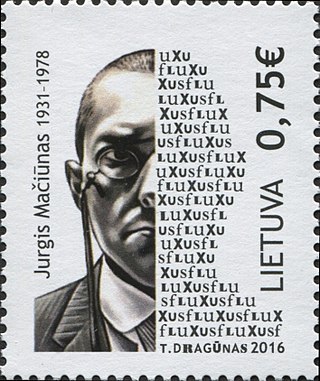Related Research Articles
A pseudonym or alias is a fictitious name that a person assumes for a particular purpose, which differs from their original or true name (orthonym). This also differs from a new name that entirely or legally replaces an individual's own. Many pseudonym holders use them because they wish to remain anonymous, but anonymity is difficult to achieve and often fraught with legal issues.
A pen name is a pseudonym adopted by an author and printed on the title page or by-line of their works in place of their real name.

Fluxus was an international, interdisciplinary community of artists, composers, designers and poets during the 1960s and 1970s who engaged in experimental art performances which emphasized the artistic process over the finished product. Fluxus is known for experimental contributions to different artistic media and disciplines and for generating new art forms. These art forms include intermedia, a term coined by Fluxus artist Dick Higgins; conceptual art, first developed by Henry Flynt, an artist contentiously associated with Fluxus; and video art, first pioneered by Nam June Paik and Wolf Vostell. Dutch gallerist and art critic Harry Ruhé describes Fluxus as "the most radical and experimental art movement of the sixties".
Industrial music is a genre of music that draws on harsh, mechanical, transgressive or provocative sounds and themes. AllMusic defines industrial music as the "most abrasive and aggressive fusion of rock and electronic music" that was "initially a blend of avant-garde electronics experiments and punk provocation". The term was coined in the mid-1970s with the founding of Industrial Records by members of Throbbing Gristle and Monte Cazazza. While the genre name originated with Throbbing Gristle's emergence in the United Kingdom, artists and labels vital to the genre also emerged in the United States and other countries.

Kevin Llewellyn Callan, better known as Stewart Home, is an English artist, filmmaker, writer, pamphleteer, art historian, and activist. His novels include the non-narrative 69 Things to Do with a Dead Princess (2002), and the re-imagining of the 1960s in Tainted Love (2005). Earlier parodistic pulp fictions work includes Pure Mania, Red London, No Pity, Cunt, and Defiant Pose which pastiche the work of 1970s British skinhead pulp novel writer Richard Allen and combine it with pornography, political agit-prop, and historical references to punk rock and avant-garde art.
Neoism is a parodistic -ism. It refers both to a specific subcultural network of artistic performance and media experimentalists, and, more generally, to a practical underground philosophy. It operates with collectively shared pseudonyms and identities, pranks, paradoxes, plagiarism and fakes, and has created multiple contradicting definitions of itself in order to defy categorization and historization.

Mail art, also known as postal art and correspondence art, is an artistic movement centered on sending small-scale works through the postal service. It developed out of what eventually became Ray Johnson's New York Correspondence School and the Fluxus movements of the 1960s. It has since developed into a global, ongoing movement.
Luther Loide Blissett is a former professional footballer and manager who played for the England national team during the 1980s. Born in Jamaica, Blissett played as a striker, and is best known for his time at Watford, whom he helped win promotion from the Fourth Division to the First Division. As of 2022, Blissett holds Watford's all-time records for appearances and goals, having played 503 games and scored 186 goals.

Luther Blissett is a multiple-use name, an "open pop star" informally adopted and shared by hundreds of artists and activists all over Europe and the Americas since 1994. The pseudonym first appeared in Bologna, Italy, in mid-1994, when a number of cultural activists began using it for staging a series of urban and media pranks and to experiment with new forms of authorship and identity. From Bologna the multiple-use name spread to other European cities, such as Rome and London, as well as countries such as Germany, Spain, and Slovenia. Sporadic appearances of Luther Blissett have been also noted in Canada, the United States, Finland, and Brazil.

George Maciunas was a Lithuanian American artist, born in Kaunas. A founding member and the central coordinator of Fluxus, an international community of artists, architects, composers, and designers, he is most famous for organising and performing early happenings and for assembling a series of highly influential artists' multiples.

Isaac "Zack" Werner is a Canadian artist, producer, entertainment lawyer and manager.
Karen Eliot is a multiple identity, a shared pen name that anyone is welcome to use for activist and artistic endeavours. It is a manifestation of the "open pop star" idea within the Neoist movement. The name was developed in order to counter the male domination of that movement, the most predominant multiple-use names previously being Monty Cantsin and Luther Blissett.

Istvan Kantor is a Canadian performance and video artist, industrial music and electropop singer, and one of the early members of Neoism.
John Berndt is a musician and organizer based in Baltimore, Maryland who is best known as an extended-technique experimental saxophonist and electronic musician. He participated in the second wave of the neoism cultural movement, the first wave having consisted of Monty Cantsin, Istvan Kantor, and Blaster Al Ackerman, amongst many others. Berndt's participation in Neoism began after the 1st eight Neoist Apartment Festivals during the "64th International Neoist Apartment Festival" in 1986 in Berlin and subsequently in the "One Millionth" in New York City in late 1988 and the "13th" in Paris in 1994. Conceptual work by Berndt was shown at Documenta X, in Kassel, in 1997.

Blaster Al Ackerman was an American mail artist and writer. Ackerman had been active in various subcultures since the early 1970s.
A multiple-use name or anonymity pseudonym is a name used by many different people to protect anonymity. It is a strategy that has been adopted by many unconnected radical and cultural groups, where the construct of personal identity has been criticised.
Rivington School was a movement that emerged from the East Village art scene in the 1980s in New York City. Most of the artists of the Rivington School were either involved in welding, forging, performance or street painting. The group started in 1983 and named themselves after an abandoned public school house building located on Rivington Street. The school was located across from a club No Se No where many artists would meet and performances were held. The group is most noted for "massive junk sculpture installations on the Lower East Side," and other forms of metal public sculpture.

Vittore Baroni, is an Italian mailartist, music critic and explorer of countercultures. Since the mid-1970s he has been one of the most active and respected promoters and documenters of mail art.
The Seven By Nine Squares was an early internet site, and art project, led by Florian Cramer. It was designed as an interactive literary experience, and speaks primarily of the concepts of Neoism, collective identity, and Monty Cantsin.

Parking Non-Stop is a north Wales based psychogeographical musical/artistic collective who experiment in combining soundscape and field recordings with spoken word and music. The group consist of the poet Zoë Skoulding and musicians Alan Holmes and Dewi Evans, often in collaboration with additional musicians and artists.
References
- 1 2 C. Carr (9 April 2012). On Edge: Performance at the End of the Twentieth Century. Wesleyan University Press. pp. 105–. ISBN 978-0-8195-7242-4.
- ↑ http://www.neoism.info/neoist_book.pdf. URL last accessed 2014-04-07.